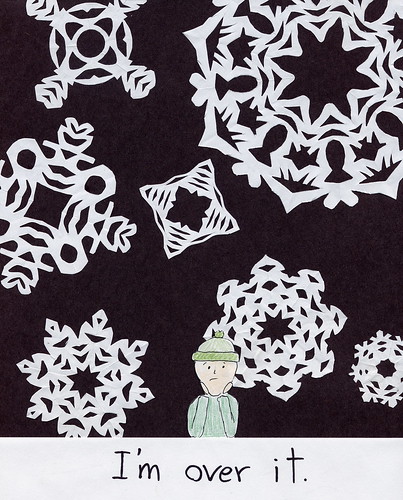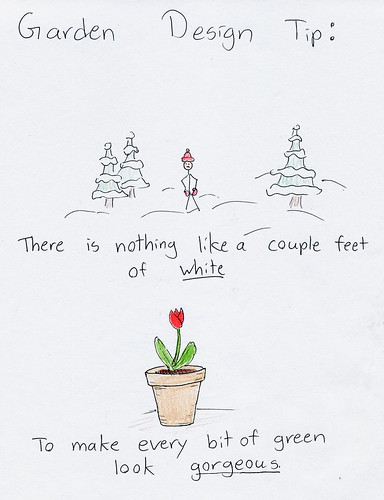Leslie, who blogs over at Mountain Plover blogs.icta.net/plover, send me a great question.
My question is about adding compost... can you add too much? And if so, what harm does it
In my master gardener training, we were told to always recommend adding 4 inches of organic matter, dug in 8 - 12 inches. Colorado soils are notorious for their lack of humus. However, my brother-in-law (who lives near Denver) had a soil test (from an independent lab) come back telling him he had too much compost! (He has been growing veggies for a number of years, adding compost and shredded leaves to the soil every fall.) Apparently, this was throwing his other minerals out of balance. They actually recommended adding lime and gypsum, two things CSU told us to avoid. Now I'm totally confused.
"The compost and leaves have narrowed the calcium to phosphorous and the calcium to potassium ratio. Both should be 18 to 1. The reason a small amount of limestone is added is because calcium and potassium compete for space on the clay colloid. When limestone is applied it will push potassium off the clay colloid and then be taken up by plants or will leach below the root zone. This is a little trick to help reduce excessive potassium faster. The gypsum is applied because it will help correct a serious situation in your soil: excess sodium. Once applied, the calcium and sulfate in gypsum will disassociate. The sulfates combine with sodium to become sodium sulfate and is leached in the presence of adequate moisture. This will help reduce your sodium level. Having sodium at 166ppm is much worse by far than having calcium at 8000 lbs. per acre or even higher. High calcium levels are not that much of an issue. Calcium nitrate is applied to bump up the nitrates in the soil for quick, early growth in the spring. The amount of accumulated calcium will be negligible."
Whew! What a lot of great questions! And a lot of excessively technical language from the soil lab. I'll try and break this down in bits and see if we can make sense of it all.
Fertilizer Vrs. Soil Amendment
When thinking about adding stuff to soil, I like to mentally break things down in to two categories: Soil amendments and fertilizer. I think of things like peat moss, charcoal, sand, as soil amendments. Their primary purpose is to change the texture and structure of your soil so it is a better space for plant roots and beneficial microorganisms to grow in. Fertilizers, on the other hand, are plant vitamin pills, providing specific chemicals they need to supplement their main diet of carbohydrates they make from water, sunlight, and air. It is pretty hard to overdose on most soil amendments. You can't really have too much organic matter in your soil – after all, peat or coir based potting mixes are essentially 100% organic matter. Fertilizers, on the other hand, are usually damaging to plants at high levels, just as you can overdose on almost any vitamin.
Compost is, of course, both a fertilizer AND a soil amendment. Compost has a lot of organic matter which improves soil texture, and it also has varying amounts of nitrogen, phosphorous, etc. The exact amounts will vary widely depending on that your compost is made from, but certainly you can add too much fertilizer by adding too much compost. The most common compost over-dose, in my experience, is adding way too much nitrogen when using composted manure, but you can overdo other elements as well.
To lime or not to lime?
The rest of Leslie's question is interesting because it make, once again, the point that all gardening is local. The soil testing lab recommended adding lime and gypsum – but her Master Gardening training at Colorado State said to avoid both of those! What gives?The usual reason to add lime or gypsum to soil is to correct a calcium deficiency, and/or to make a soil less acidic. Where I live, we get around 30-40 inches of precipitation a year and all the water leaches out the alkaline chemicals, usually producing an acidic, calcium deficient soil. Around here, adding lime is pretty much standard practice. Leslie gardens with only 16 inches of precipitation a year, and that lack of water lets calcium build up in the soil, so adding more is just making a problem worse. There are exceptions to the rainfall-soil pH connection of course... lucky people like Gail who, thanks to limestone bedrock, have alkaline soil despite a wet climate. I gardened briefly on limestone when I was at Ohio State... it was a pain. Suddenly rhododendrons went from over-planted and boring to difficult and desirable. Because wet, alkaline soils are rare, it is hard to find plants adapted to those conditions.
All of which is a bit beside the point in this case. The soil lab is recommending lime and gypsum here for a different reason. Leslie's brother has too much potassium and sodium in his soil, and adding lime and gypsum is a kind of chemistry trick to let those chemicals leach out of the soil faster. It will increase the amount of calcium in his soil, which isn't a good thing, but having lots of sodium is a much WORSE thing, so is the best option for the healthiest soil.
Get Tested
The bottom line here is: get your soil tested periodically by a qualified lab in your area. Soils vary radically depending on your climate, they type of bed rock you have, and how you manage it. Compost is a catch-all term, and composted cow manure is going to be very different than composted yard waste or composted coffee grounds. Find out what your soil is actually like now, so you can make the right choice on what to add to it in the future.Have a question? Get a sciency answer! Just e-mail me (engeizuki at gmail dot com) or ask one in the comments!













